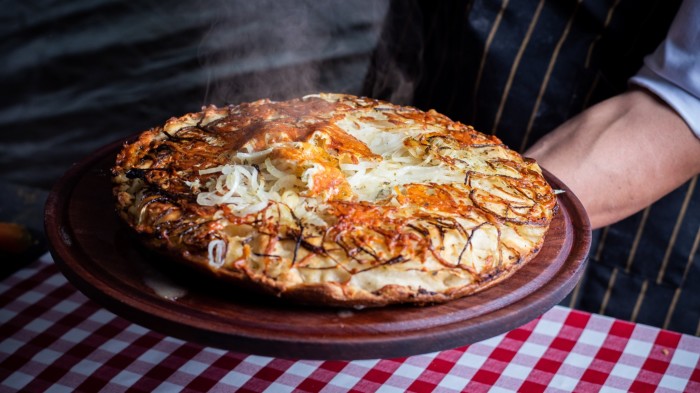Unlock the Editor’s Digest for free
Roula Khalaf, Editor of the FT, selects her favourite stories in this weekly newsletter.
In the hierarchy of best loved pizzas there is the Napolitana and the Romana, maybe even the New York slice and Chicago deep dish. What is not on the list is the Argentine. Yet the South American country has one of the world’s biggest pizza cultures — and it would like the rest of the world to know about it.
Argentine beef may be more famous but pizzerías outnumber grill houses in Buenos Aires, according to the last city register. The product served is a fusion of local tastes and the Italian ancestry that roughly half of Argentines claim: a thick, spongy dough, loaded with as much as half a kilo of elastic cheese and covered in a layer of white onion or sliced ham, traditionally accompanied by a chickpea pancake.
The most common phrase I’ve heard Argentines say when gathered around a pizza is “es una bomba”. This translates literally to “it’s a bomb” and means both “amazing” and “incredibly heavy”. Foreigners are generally more circumspect. “I just wish they wouldn’t call it pizza,” said one European diplomat.
Argentina’s pizza association not only intends to keep calling its local creation pizza, but it wants the rest of the world to acknowledge it too. This year it has mounted a campaign for global recognition that will bear its first fruits in early April. Madrid’s pizza championship, one of at least half a dozen such international competitions, will become the first overseas event to include an Argentine pizza category.
“We want Argentine pizza to be in that list that everyone thinks about, alongside the Italian and American styles, and it starts with this championship,” says Lorena Fernández, president of the association, which acts as both training academy and lobby group for Argentine pizza chefs.
Fernández has her sights set high. “The dream would be to get a category at Parma,” she says, referring to the world’s most prestigious pizza contest.
Ties between Argentines and Italians are close. So close that President Javier Milei became an Italian citizen on a trip to Rome last year.
Millions of Italian migrants settled in Argentina in the late 19th and early 20th century, lured by the availability of land and agricultural jobs. Most came from the northern Liguria region. Many settled in the impoverished Buenos Aires neighbourhood of La Boca, where they popularised focaccia-style bread, which they and Spanish migrants began to top with cheese and other abundant Argentine produce.
Pizza popularity endured even as Argentina suffered repeated economic crises. The heavy pies, which can easily feed four people, were an affordable treat. Local palates are faithful enough that attempts by Pizza Hut and Dominoes to crack the market in the 1980s and 1990s foundered, though Napolitana pizza shops now flourish in the trendier neighbourhoods of Buenos Aires.
Argentine migrants have also begun to establish a foothold for their pizza in cities such as Madrid and Mexico City.
But Italians remain sceptical of Argentina’s ersatz version of their cuisine. Argentine cheesemakers’ use of names like Parmigiano was a sticking point in the 25-year long EU-Mercosur deal trade negotiations. And in 2023, when soccer superstar Lionel Messi shared images of his order from an Argentine-style pizzería in Miami, Italian social media users asked if it was “grounds for legal action”.
In Argentina, however, national pizza pride holds strong. In March, a group of chefs huddled over the steel surfaces of the pizza association’s airy classroom, kneading dough and warming ovens as they prepared for this year’s European pizza competitions.
In the balmy hallway, Ezequiel Ortigoza, 31, who last year became the first Latin American chef to place on the Parma pizza championship podium in 32 years, says he would love to represent Argentine pizza.
But Ortigoza, who grew up working in Buenos Aires’ famous pizza parlours Guerrín and El Cuartito, says Argentine pizza needs to evolve to win over the world. Younger generations are refining the art, fermenting the dough for longer to make it easier to digest. “We have a great product, but it can be much better,” he says. “It doesn’t have to be so heavy to be Argentine.”
Read the full article here

